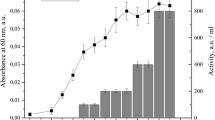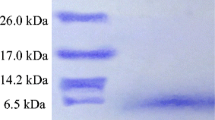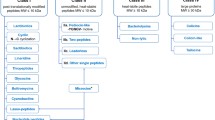Abstract
Several putative class II bacteriocin-like genes were identified in Lactobacillus casei ATCC 334, all of which might encode peptides with a double-glycine leader. Six peptides encoded by these genes were heterologously expressed in Escherichia coli and then partially purified in order to test their bacteriocin activity. The results revealed that the mature LSEI_2163 peptide was a class IId bacteriocin that exhibited antimicrobial activity against some lactobacilli and several Listeria species. Similarly, mature LSEI_2386 was a putative pheromone peptide that also had significant bacteriocin activity against several Listeria species. The activities of both peptides tolerated 121°C for 30 min but not treatment with proteinase K or trypsin. The two Cys residues located at positions 4 and 24 in the mature LSEI_2163 peptide were shown by mass spectrometry to form a disulfide bridge, which was required for optimal antibacterial activity. However, replacement of one or both Cys with Ser would cause significant reduction of the antibacterial activity, the reduction being greater when only one of the Cys residues (C4S) was replaced than when both (C4S/C24S) were replaced.


Similar content being viewed by others
References
Anderssen EL, Diep DB, Nes IF, Eijsink VG, Nissen-Meyer J (1998) Antagonistic activity of Lactobacillus plantarum C11: two new two-peptide bacteriocins, plantaricins EF and JK, and the induction factor plantaricin A. Appl Environ Microbiol 64:2269–2272
Boman HG (2003) Antibacterial peptides: basic facts and emerging concepts. J Intern Med 254:197–215
Brurberg MB, Nes IF, Eijsink VG (1997) Pheromone-induced production of antimicrobial peptides in Lactobacillus. Mol Microbiol 26:347–360
Cleveland J, Montville TJ, Nes IF, Chikindas ML (2001) Bacteriocins: safe, natural antimicrobials for food preservation. Int J Food Microbiol 71:1–20
Cotter PD, Hill C, Ross RP (2005) Bacteriocins: developing innate immunity for food. Nat Rev Microbiol 3:777–788
Diep DB, Havarstein LS, Nes IF (1996) Characterization of the locus responsible for the bacteriocin production in Lactobacillus plantarum C11. J Bacteriol 178:4472–4483
Diep DB, Godager L, Brede D, Nes IF (2006) Data mining and characterization of a novel pediocin-like bacteriocin system from the genome of Pediococcus pentosaceus ATCC 25745. Microbiology 152:1649–1659
Fimland G, Eijsink VG, Nissen-Meyer J (2002) Mutational analysis of the role of tryptophan residues in an antimicrobial peptide. Biochemistry 41:9508–9515
Franz CM, van Belkum MJ, Holzapfel WH, Abriouel H, Galvez A (2007) Diversity of enterococcal bacteriocins and their grouping in a new classification scheme. FEMS Microbiol Rev 31:293–310
Garneau S, Martin NI, Vederas JC (2002) Two-peptide bacteriocins produced by lactic acid bacteria. Biochimie 84:577–592
Hauge HH, Mantzilas D, Moll GN, Konings WN, Driessen AJ, Eijsink VG, Nissen-Meyer J (1998) Plantaricin A is an amphiphilic alpha-helical bacteriocin-like pheromone which exerts antimicrobial and pheromone activities through different mechanisms. Biochemistry 37:16026–16032
Havarstein LS, Diep DB, Nes IF (1995) A family of bacteriocin ABC transporters carry out proteolytic processing of their substrates concomitant with export. Mol Microbiol 16:229–240
Holo H, Nilssen O, Nes IF (1991) Lactococcin A, a new bacteriocin from Lactococcus lactis subsp. cremoris: isolation and characterization of the protein and its gene. J Bacteriol 173:3879–3887
Huhne K, Axelsson L, Holck A, Krockel L (1996) Analysis of the sakacin P gene cluster from Lactobacillus sake Lb674 and its expression in sakacin-negative Lb. sake strains. Microbiology (Reading, England) 142:1437–1448
Kalmokoff ML, Banerjee SK, Cyr T, Hefford MA, Gleeson T (2001) Identification of a new plasmid-encoded sec-dependent bacteriocin produced by Listeria innocua 743. Appl Environ Microbiol 67:4041–4047
Kjos M, Snipen L, Salehian Z, Nes IF, Diep DB (2010) The abi proteins and their involvement in bacteriocin self-immunity. J Bacteriol 192:2068–2076
Klaenhammer TR (1988) Bacteriocins of lactic acid bacteria. Biochimie 70:337–349
Maqueda M, Galvez A, Bueno MM, Sanchez-Barrena MJ, Gonzalez C, Albert A, Rico M, Valdivia E (2004) Peptide AS-48: prototype of a new class of cyclic bacteriocins. Curr Protein Pept Sci 5:399–416
Moretro T, Naterstad K, Wang E, Aasen IM, Chaillou S, Zagorec M, Axelsson L (2005) Sakacin P non-producing Lactobacillus sakei strains contain homologues of the sakacin P gene cluster. Res Microbiol 156:949–960
Nikolskaya AN, Galperin MY (2002) A novel type of conserved DNA-binding domain in the transcriptional regulators of the AlgR/AgrA/LytR family. Nucleic Acids Res 30:2453–2459
Nissen-Meyer J, Nes IF (1997) Ribosomally synthesized antimicrobial peptides: their function, structure, biogenesis, and mechanism of action. Arch Microbiol 167:67–77
Nissen-Meyer J, Rogne P, Oppegard C, Haugen HS, Kristiansen PE (2009) Structure-function relationships of the non-lanthionine-containing peptide (class II) bacteriocins produced by gram-positive bacteria. Curr Pharm Biotechnol 10:19–37
Oppegard C, Rogne P, Emanuelsen L, Kristiansen PE, Fimland G, Nissen-Meyer J (2007) The two-peptide class II bacteriocins: structure, production, and mode of action. J Mol Microbiol Biotechnol 13:210–219
Richard C, Drider D, Elmorjani K, Marion D, Prevost H (2004) Heterologous expression and purification of active divercin V41, a class IIa bacteriocin encoded by a synthetic gene in Escherichia coli. J Bacteriol 186:4276–4284
Saenz Y, Rojo-Bezares B, Navarro L, Diez L, Somalo S, Zarazaga M, Ruiz-Larrea F, Torres C (2009) Genetic diversity of the pln locus among oenological Lactobacillus plantarum strains. Int J Food Microbiol 134:176–183
Tichaczek PS, Vogel RF, Hammes WP (1994) Cloning and sequencing of sakP encoding sakacin P, the bacteriocin produced by Lactobacillus sake LTH 673. Microbiology 140:361–367
Venema K, Abee T, Haandrikman AJ, Leenhouts KJ, Kok J, Konings WN, Venema G (1993) Mode of action of lactococcin B, a thiol-activated bacteriocin from Lactococcus lactis. Appl Environ Microbiol 59:1041–1048
Venema K, Dost MH, Venema G, Kok J (1996) Mutational analysis and chemical modification of Cys24 of lactococcin B, a bacteriocin produced by Lactococcus lactis. Microbiology 142:2825–2830
Wang G, Li X, Wang Z (2009) APD2: the updated antimicrobial peptide database and its application in peptide design. Nucleic Acids Res 37:D933–D937
Acknowledgments
This work is supported in part by a grant (NSC99-2628-B007-001-MY3) from the National Science Council of Taiwan, R.O.C.
Author information
Authors and Affiliations
Corresponding author
Electronic supplementary material
Below is the link to the electronic supplementary material.
ESM 1
(PDF 154 kb)
Rights and permissions
About this article
Cite this article
Kuo, YC., Liu, CF., Lin, JF. et al. Characterization of putative class II bacteriocins identified from a non-bacteriocin-producing strain Lactobacillus casei ATCC 334. Appl Microbiol Biotechnol 97, 237–246 (2013). https://doi.org/10.1007/s00253-012-4149-2
Received:
Revised:
Accepted:
Published:
Issue Date:
DOI: https://doi.org/10.1007/s00253-012-4149-2




